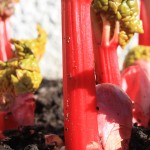 As the planting season approaches, we ponder where to plant the seeds in the garden. HORT-HINTS III, published by the Extension Division at the University of Saskatchewan suggests dividing gardens into zones. The purpose is to rotate crops from one zone to the next in order to reduce the chance of disease and for nutritional reasons. The rule of thumb is: ” Don’t plant the same veggies in the same spot two years running.”
As the planting season approaches, we ponder where to plant the seeds in the garden. HORT-HINTS III, published by the Extension Division at the University of Saskatchewan suggests dividing gardens into zones. The purpose is to rotate crops from one zone to the next in order to reduce the chance of disease and for nutritional reasons. The rule of thumb is: ” Don’t plant the same veggies in the same spot two years running.”
Where to Seed
If you have a small garden, divide it into four areas and plant a different plant group in each area every year, beginning the rotation again at the end of four years. Plant the following in each zone:
- The cabbage family
- Legumes that fix nitrogen, such as peas and beans
- Corn, carrots, beets and onions
- Vine crops such as squash, cucumber, pumpkin and melon
For a larger garden the six zones suggested are:
- The cabbage family
- Vine crops
- Legumes
- Corn
- Onions
- Potatoes
Some vegetables are depleters that use a lot of minerals, others are replenishers. For example, corn and members of the cabbage family require a great deal of nitrogen. If these plants are planted in the same area year after year, they deplete the soil of nitrogen. Peas and beans are able to fix nitrogen from the air, use it for their own growth and leave some behind in the soil for future crops.
Some vegetables have shallow roots (lettuce and radishes) and absorb nutrients from the upper layers of the soil, while others have deep roots (potatoes, carrots, turnips, tomatoes and beets) which absorb nutrients from a lower depth. This is another reason for rotating crops, to rotate shallow and deep rooted crops.
Crop rotation is especially effective in controlling insects that feed on only one type of vegetable and do not move very fast or very far (such as Colorado potato beetle). In the absence of their host plants, most root-dwelling fungi (such as fusarium of tomato, potato and strawberry) tend to die out.
When to Seed
To seed early or late depends on many factors. An advantage to early seeding is to have early – usually higher yields.
Germination of some seeds occurs at soil temperatures as low as 35°F (2°C), while other plants require higher soil temperatures. The lower the temperature of the soil the slower the germination. Seeds may rot if soils are excessively cold and wet. This is especially true for larger seeds with a high sugar content such as peas.
Some vegetables to try seeding early in the spring are parsnips, carrots, onions (from seed or sets), garlic cloves, spinach, lettuce, radish and beets.
Vegetables such as corn, beans, vines, tomatoes and peppers are warm season vegetables that will not germinate in cold soil.
Planting early runs the risk of frost. Early seeded crops are usually capable of withstanding light frosts, but severe freezing temperatures can kill young seedlings. Transplants started indoors are not as hardy as seed started outdoors. Even light freezing temperatures can kill transplants.
Source: HORT-HINTS III, Extension Division, University of Saskatchewan.
HORT-HINTS III and other gardening books are available at the U-Learn Centre, Extension Division, Room 125 Kirk Hall, 117 Science Place, University of Saskatchewan, Saskatoon, SK. S7N 5C8, Ph. 306-966-5565, Fax 306-966-5567, e-mail: , or visit their website at: www.extension.usask.ca
By Alma Copeland, Home Economist






